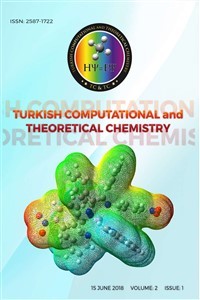A Computational study predicting the chemical reactivity behavior of 1-substituted 9-ethyl-βCCM derivatives: DFT- Based Quantum Chemical Descriptors
Abstract
This article deals with the calculation of the quantum chemical
parameters of 1-substituted βCCM compounds that can be used as effective drugs
in the treatment of many diseases. All DFT geometry optimizations and frequency
calculations have been performed in 10 different solvent environments (by using
the PCM) except for the gas phase and with 3 different basis sets which are 631G(d,p),
631+G(d,p) and 6311++G(d,p) to explaine both the solvent and basis set effect
on chemical reactivity behavior. The study revealed that
the structure A is the most reactive
structure because its Energy Gap is the lowest one than the other structures, also
in according with calculated global hardness values of the each di-substituted
structure it is the soft structure which means it can easily interact with any
receptor site than the other di-substituted structures while the structure D has the highest Energy Gap which seems it is the less reactive structures
in according with these results. Moreover, the structure A is the more active than the other
structures for an electrophilic attack reactions because of its highest
electrophilicity index value. Quantitative chemical identifiers were used to
determine which molecules were more active or less active, but MEP diagrams
were also drawn to illustrate which molecules interact with an external
molecule group in electrophilic / nucleophilic reactions and whether they will
act electrophilic or nucleophilic. MEP diagrams have also shown that the
structure A has the lowest electron
density on its surface. We expect that the findings of this study obtained from
extensive and time consuming calculations and analyzes will be an important
source of information in the synthesis of less side effect ligands or compounds
that can treat many diseases in the future.
References
- 1. Lippke KP, Schunack WG, Wenning W, Müller WE (1983) β -Carbolines as Benzodiazepine Receptor Ligands. 1. Synthesis and Benzodiazepine Receptor Interaction of Esters of β -Carboline-3-carboxylic Acid. J. Med. Chem. 26: 499-503. 2. Hagen TJ, Skolnick P, Cook JM (1987) Synthesis of 6-Substituted β -Carbolines That Behave as Benzodiazepine Receptor Antagonists or Inverse Agonists. J Med Chem 30: 750-753. 3. Dorey G, Poissonnet G, Potier MC, Carvalho LP, Venault P, Chapouthier G, Rossier J, Potier P, Dodd RH (1989) Synthesis and Benzodiazepine Receptor Affinities of Rigid Analogues of 3-Carboxy- β-carbolines: Demonstration That the Benzodiazepine Receptor Recognizes Preferentially the s-Cis Conformation of the 3-Carboxy Group. J Med Chem 32: 1799-1804.
Abstract
References
- 1. Lippke KP, Schunack WG, Wenning W, Müller WE (1983) β -Carbolines as Benzodiazepine Receptor Ligands. 1. Synthesis and Benzodiazepine Receptor Interaction of Esters of β -Carboline-3-carboxylic Acid. J. Med. Chem. 26: 499-503. 2. Hagen TJ, Skolnick P, Cook JM (1987) Synthesis of 6-Substituted β -Carbolines That Behave as Benzodiazepine Receptor Antagonists or Inverse Agonists. J Med Chem 30: 750-753. 3. Dorey G, Poissonnet G, Potier MC, Carvalho LP, Venault P, Chapouthier G, Rossier J, Potier P, Dodd RH (1989) Synthesis and Benzodiazepine Receptor Affinities of Rigid Analogues of 3-Carboxy- β-carbolines: Demonstration That the Benzodiazepine Receptor Recognizes Preferentially the s-Cis Conformation of the 3-Carboxy Group. J Med Chem 32: 1799-1804.
Details
| Journal Section | Research Article |
|---|---|
| Authors | |
| Publication Date | June 15, 2018 |
| Submission Date | May 31, 2017 |
| Published in Issue | Year 2018 Volume: 2 Issue: 1 |
Cite
Journal Full Title: Turkish Computational and Theoretical Chemistry
Journal Abbreviated Title: Turkish Comp Theo Chem (TC&TC)


